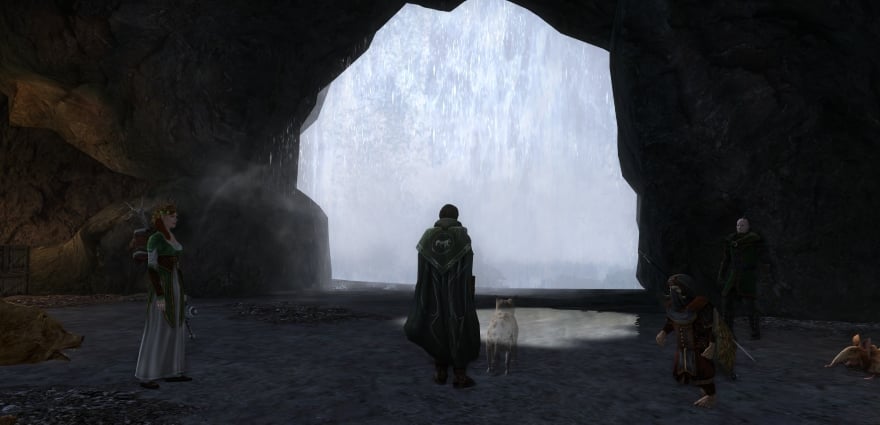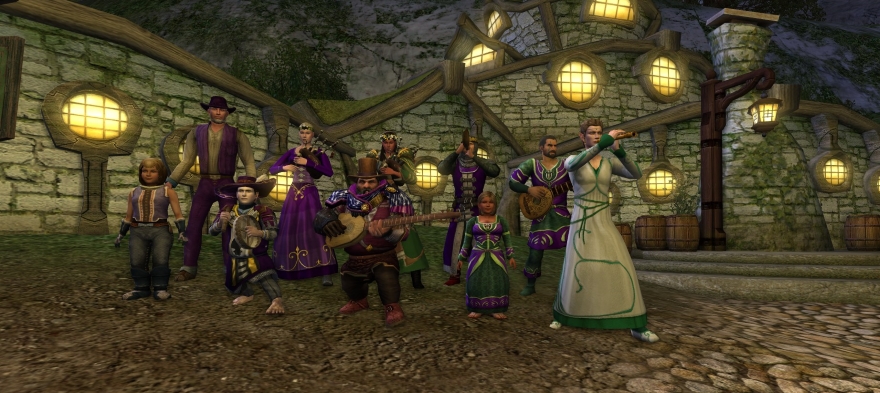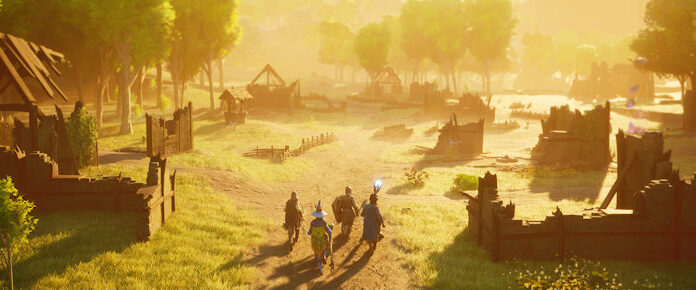
Sure, why not? It’s still a little too early to tell, but we could be seeing a nice little LOTRO renaissance right now, and I bet that there are more than a few players who are checking the game out for the first time after reading the news and hearing recommendations from others. Considering that it’s a massive MMORPG with 10 years of content and expansions, I could see how it might be overwhelming during your first week.
A true guide would probably take so much longer than the space I have this week, so let me present a quick and dirty starting guide to the this wonderful MMO and then point you to LOTRO Wiki for any further questions (seriously, it’s a great resource!). Let’s get started!
Server
After you create your account and before you actually load up the game, you’ll be prompted to select a server. As the semi-recent merges have created healthy populations on all remaining shards, it’s up to you to choose one. Europe has one official RP server and North America has an RP-encouraged server, but other than that, the rulesets are all the same.
Creating your character
LOTRO has five (soon to be six) races and 10 classes from which to choose. There are limits with your combinations, as some classes are only available to certain races (such as the Captain to the Race of Man or the Beorning to the Beornings). Also, there is no option to select a female Dwarf (it’s a lore thing, but if you want to roleplay a bearded Dwarf female, no one will stop you). Each race has some racial talents and skills, but for the most part these are very minor and are not important to your final selection.
Wardens and Rune-keepers come with the purchase of the Mines of Moria expansion, while Beornings must be bought by any player separately.
Most LOTRO classes employ some sort of hybridization of roles. There’s the Captain (tank, healer, and melee fighter with a pet), Lore-master (healer and debuffer with animal pets), Rune-keeper (healer and nuker), Minstrel (also a healer and long-range shouter with more of a musical approach), Beorning (tank, healer, and melee fighter with shapeshifting), Guardian (your heavy duty tank), Champion (melee fighter who can also tank), Warden (combo-using spear fighter that can tank), Hunter (long-range nuker), and Burglar (dual-wielding Rogue archetype). Pick whichever interests you and try them out through the starting zone to see if it clicks with you.
Useful options
I always like taking a few minutes at the start of a new character to set up the game’s options. A few of the more useful options is to enable a selection indicator (which creates a line on the ground pointing to your target), move-to-attack (which automatically has your character run up to an enemy), show trivial quest icons (because you WILL outlevel quests and it’s always nice to see them on the screen), loot all (LOTRO automatically loots anything you kill without you needing to click on the corpse), and jack up chat window opacity so you can actually read it. Some players like to disable chat channels for trade, LFF, and world chat, but that’s up to you. Sometimes these can be useful and entertaining channels, and sometimes they are Barrens chat incarnate.
Another tip is to merge all of your inventory bags into one big bag, which can be done courtesy of an update from this past year. It’s just easier to see and work with a single bag, in my opinion.
Navigating free-to-play
There’s always a lot of confusion about the game’s business model, so let me straighten it out. LOTRO employs a hybrid free-to-play model, meaning that you can either subscribe or play for free with limitations. Subscribers still have to buy expansions, but otherwise get all of the content for free and a monthly point stipend. Free players get all content up through level 30 for free, and only the epic storyline until Helm’s Deep (the fifth expansion) after that.
If you’re new, I’d recommend trying out the game for a while (30 levels is a few weeks’ of play right there) and see if it’s something you want to play for a long time. If you like it, you’re going to want to drop some money on it in some way. The best deal you can get right now is to hunt around for the four-expansion pack (with covers the first four expansions of the game) and then pick up Helm’s Deep separately when you can. It’s entirely possible that some good sales might be coming with this year’s new expansion, so keep an eye on that.
All players can earn LOTRO Points (LP) by playing the game and hitting achievements (which you do quite frequently). These can be saved up to buy zone packs or even expansions, although those are pretty pricey. I would highly recommend that any player buy the riding skill (95 LP) right out of the tutorial, because there is no way that you want to be running across this gigantic world.
It should also be noted that free players are bumped up to “premium” status if they spend any real money on the store. Premium accounts receive a few nicer perks but certainly not as full-featured as subscribers.
Jumping starting zones
LOTRO has three starting zones: Ered Luin (Elves and Dwarves), Bree-land (Beornings and Man), and The Shire (Hobbits). Once you get out of the tutorial and instanced intro zone, you’ll be in one of these three regions. But the interesting thing is that you have the option to take a stable mount and ride over to another region if you prefer to tackle your level 6 through 15 experience somewhere else. So Elves can level in the Shire, Hobbits can go to Bree-land, and so on.
As long as you keep to the epic storyline as your main narrative guide, you’ll be fine. Eventually around level 15, all players will be funneled into Bree and then progress from there.
From Eriador to Mordor
There are three main types of quests in this game. The first are your standard boilerplate missions that can be part of larger chains or one-and-done events. Then there are tasks, which are fairly dull repeatable quests if you need reputation or (for some bizarre reason) experience. Although experience really should come quite easily in this game if you do all of the normal quests.
Then there’s the epic storyline, or the “epic,” as it’s sometimes called. This is the overarching narrative, the big story that will take you from the start of the game all of the way to Mordor. The epic is divided into volumes, books, and chapters, and they offer the best questing rewards and tales for the most part. From Volume 2 on, you do need to do the epic (some areas won’t unlock unless you do), so don’t avoid them. However, Volume 1 is largely seen as optional. You certainly can do it, and it will take you all over Eriador, but it’s more travel intensive than the later volumes and not strictly needed if you simply want to do zone quests. It’s also less tethered to Tolkien’s books than the later volumes, which is a factor for some players. It’s your choice.
LOTRO does allow for some choice of questing areas as you level up, particularly in the first 50 levels. For example, North Downs and Evendim both have questing options in the level 30 to 40 range, so you could viably do one and ignore the other. By your late 40s, you’re going to want to make sure you have started Volume 2 of the epic and are making your way to Moria.
Traits, deeds, and you
There are two large and intertwined systems in the game that all players deal with, and those are the deed system and trait system. Deeds are LOTRO’s version of achievements, giving you side activities that pay out in various rewards (titles, LP, currency, gear, and traits). Traits are passive or active abilities that can be equipped to your character to provide you with certain skills (such as stealthing as a Hobbit or quick traveling back to your home city) or a boost in stats.
You don’t have to do all of the deeds, of course, although some are more useful than others, and most all give you LP to spend on store purchases. Generally I’d say that class and racial traits are more important than virtues, which are statistically inferior the further you progress in the game than what you get from your gear. I always like to be working on one or two deeds at a time while I’m questing.
Class trait points are spent in the trait tree, which should be quite familiar to anyone who’s interacted with an MMO talent tree in the past.
When do I get…?
Another common question by newbies is wondering at which level do they gain access to certain features.
- Mounts: Level 6 (if you buy the riding skill from the store) or level 20 (for subscribers only)
- PvP: Monster play opens up at level 10 for those who want to participatate
- Epic Battles: Since epic battles scale characters up to level 100, you can jump in as early as level 10 using the menu interface
- Housing: Settle into your first abode at level 15 (there are five housing regions, one of which is for store-bought homes only)
- Legendary items: You have to be level 45 and going through the first part of Volume II of the epic
- Skirmishes: The first set of skirmishes (small instanced battles) opens up at level 20, although there are additional ones as you level beyond that
- War-steed: Access to mounted combat begins at level 71 at the start of the Rohan content, although you’ll need to go through a quest chain first before you get your own super-fast, super-hard to control horsey
A final note about inventory and storage
LOTRO dumps a lot of stuff at you, and while much of it is either crafting-related or simply vendor trash, you’re eventually going to want to keep a lot of it. Fortunately, the game has more than just your bag space to help out.
In any of the major cities (and a few other places), there is an NPC that gives you access to your three-in-one bank. You have a vault (standard, expandable storage), a shared storage (bank space that can be accessed by all of your characters), and a wardrobe (which makes cosmetic copies of your gear that can be used for your cosmetic outfits). If you purchase a house, you’ll get an additional storage chest in there as well.
Hope this all helps! I’m sure I’m overlooking a few dozen other things, but if I was to advise a friend, this is what I’d want him or her to know starting out in the game.
 Every two weeks, the LOTRO Legendarium goes on an adventure (horrid things, those) through the wondrous, terrifying, inspiring, and, well, legendary online world of Middle-earth. Justin has been playing LOTRO since its launch in 2007! If you have a topic for the column, send it to him at justin@massivelyop.com.
Every two weeks, the LOTRO Legendarium goes on an adventure (horrid things, those) through the wondrous, terrifying, inspiring, and, well, legendary online world of Middle-earth. Justin has been playing LOTRO since its launch in 2007! If you have a topic for the column, send it to him at justin@massivelyop.com.
















